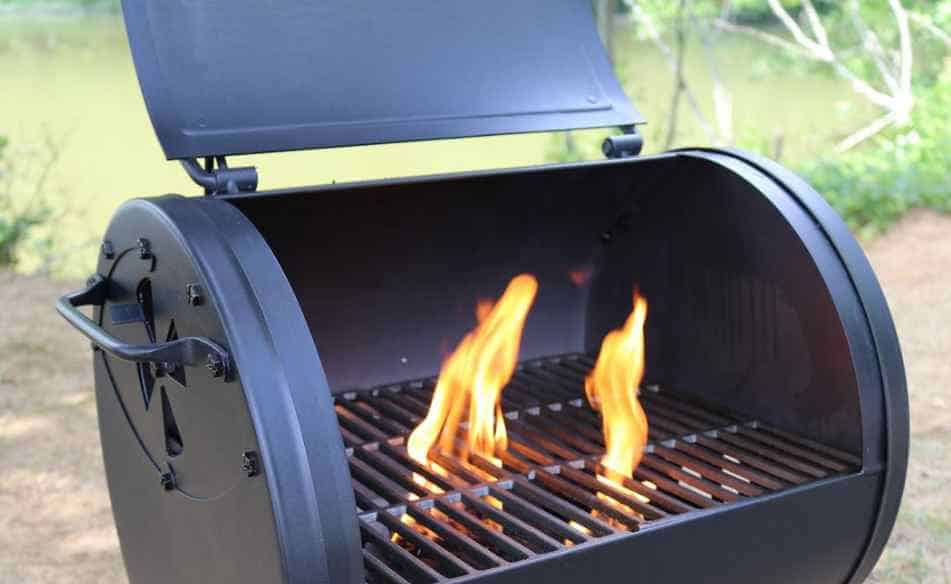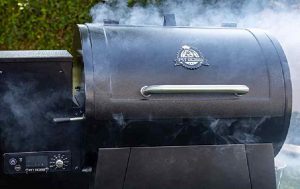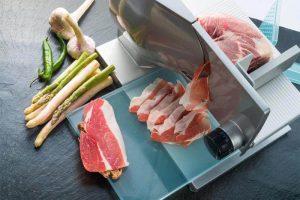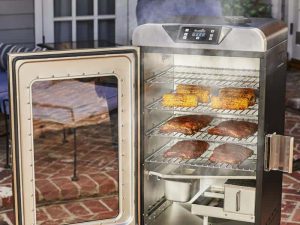Want to spice up your summer barbecue? Improving your grilling skills can be thrilling when you learn how to make mouthwatering smoked turkey and chicken, tender and flavorful ribs, and tender, juicy brisket.
Now is the time to fire up your charcoal smoker and create some tasty treats.
- What Is A Charcoal Smoker And How It Works?
- How to Use a Charcoal Smoker: Step By Step
- How to Control Charcoal Smoker Temperature?
- Charcoal Smoker Cooking Times (Chart)
What is a Charcoal Smoker and how it works?
A charcoal smoker is a cooking device that uses low, indirect heat generated by burning charcoal to smoke the food over an extended period.
Unlike a charcoal grill, a charcoal smoker focuses on slow cooking, allowing the collagen in tougher cuts of meat to break down and become mouthwateringly tender.
This process, often referred to as “low and slow” cooking, can take anywhere from 6 to 20 hours, depending on the type and size of the food being smoked.
Adding hardwood, such as hickory, cherry, or alder wood, to the charcoal smoker introduces an additional layer of flavor to the food.
Each type of wood imparts a unique taste, so it’s essential to experiment and find the perfect match for the dish you’re preparing.
Be cautious with stronger woods like mesquite, as they can overpower delicate flavors in certain foods, like chicken.
Patience is crucial when using a charcoal smoker, as the indirect heat and lengthy cooking times are what make the smoked food so tender and delicious.
With practice and a bit of experimentation, you’ll soon be able to create incredibly flavorful and tender smoked dishes using a charcoal smoker.
How to Use a Charcoal Smoker: Step By Step
Using a charcoal smoker can be a rewarding experience, but it may take some practice to perfect the process.
Here’s a step-by-step guide to help you smoke delicious and tender meats using a charcoal smoker:
1. Prepare the charcoal:
Use standard charcoal briquettes, as they burn at the ideal temperature for smoking. Avoid boutique lump charcoal, which tends to burn too hot.
Soak your chosen wood chips, such as hickory, mesquite, cherry, or apple, in water for 30 minutes before use to add a unique smoke flavor.
2. Fill the water pan:
Fill a water pan halfway with cool water to help control temperature and maintain moisture in the meat.
3. Light the charcoal:
Use a charcoal chimney or all-natural firestarters to light the charcoal. Avoid using lighter fluid to prevent unpleasant flavors. Add the lit coals to the rest of the charcoal in the smoker.
4. Add the meat:
Place your seasoned meat directly on the grill grates. If your smoker has multiple racks, use the highest one for consistent temperature control.
5. Add the wood:
Add your wood chips or chunks to the smoker at this point. There’s no need to soak the wood beforehand, as it only creates steam until it’s dry enough to produce smoke.
Related >> How to Use Wood Chips on a Charcoal Grill (Wood Flavor Chart)
6. Control the temperature:
Maintain a temperature between 220°F and 275°F for most smoked meats. Use the bottom and top vents (or dampers) on your charcoal smoker to regulate the temperature.
Open the bottom vents for more air circulation and increased heat, and open the top vents to let hot air escape and lower the temperature.
Monitor the temperature with your smoker’s built-in thermometer.
7. Smoke your meat:
Be patient, as smoking with a charcoal smoker takes time. The low and slow cooking process will result in mouthwatering, tender meats.
Remember that practice makes perfect, and experimenting with different woods, cooking times, and temperature control will help you become a master of charcoal smoking.
You can also watch this video for more information about “How to use a Charcoal Smoker” below:
How to Control Charcoal Smoker Temperature?
Maintaining a consistent temperature is crucial for a successful smoking experience, but it can be challenging for a charcoal smoker.
Here’s a guide to help you effectively control the temperature of your charcoal smoker:
1. Understand the importance of low temperatures:
Low temperatures give the smoke enough time to flavor the meat and allow the connective fibers in the meat to break down and become tender.
Aim for a temperature between 220°F and 275°F for most smoked meats.
2. Utilize the damper system:
Your smoker should have a damper system, which includes lower vents and upper vents, to control the heat inside the smoker.
Air is drawn into the bottom of the smoker, through the coals and wood, and circulates around the food before being forced out through the top.
3. Adjust the lower vents:
If the temperature is too hot (over 250°F), partially close the lower vents to limit the oxygen supply and cool the smoker down.
If the smoker is excessively hot, you might need to close one of the lower vents completely. Remember, completely closing all vents will extinguish the smoker.
4. Boost the heat when needed:
For long smoking sessions or when cooking large items like a whole ham or turkey, you might need to add coals or rearrange them to maintain the heat.
Stir the briquettes with a fire poker to knock off the ash, and for very long cooking times, add new coals to the coal chamber after relighting them in a chimney starter.
5. Control airflow with intake and exhaust vents:
The intake vent, located near the charcoal, controls the amount of air that reaches the burning coals.
Opening the vent makes the coals burn hotter while closing it reduces the heat.
The exhaust vent allows smoke and gases to escape the smoker, and closing it can lead to CO2 buildup, eventually smothering the charcoal.
6. Be patient and monitor:
Adjusting the temperature on a charcoal smoker takes time. Make small changes to the vents and wait for about 10 to 15 minutes to see the effects.
Keep an eye on the thermometer to ensure you maintain the ideal temperature range.
Remember, practice makes perfect, and learning how to control the temperature of your charcoal smoker will lead to deliciously smoked meats with a perfect balance of flavor and tenderness.
Charcoal Smoker Cooking Times:
| Meat Type | Weight | Cooking Time | Internal Temperature (°F) |
|---|---|---|---|
| Chicken (whole) | Up to 5 lbs | 2½ – 3½ hours | 165 |
| Turkey (whole) | 8-12 lbs | 4-5 hours | 165 |
| Turkey (whole) | 12-18 lbs | 8-10 hours | 165 |
| Duck (whole) | 3-4 lbs | 2-2½ hours | 180 |
| Pork Roast | 4-8 lbs | 5-6 hours | 180 |
| Pork Ribs | – | 4-6 hours | until meat pulls from the bone |
| Ham (fresh, whole) | 10-18 lbs | 8-12 hours | 170 |
| Pork Shoulder | 4-8 lbs | 8-12 hours | 190 |
| Beef Brisket | 5-6 lbs | 6-8 hours | 190 |
| Lamb/Venison Roast | 5-7 lbs | 5-6 hours | 160 |
| Game (large cuts) | 7-9 lbs | 6-8 hours | 170 |
| Beef Ribs | – | 6-7 hours | 160 |
| Fish (whole) | 8-10 lbs | 3-4 hours | 145 |
Please note that the cooking times listed above are approximate and can vary depending on the shape, thickness, and diameter of the meat.
Always use a digital meat thermometer to check the internal temperature for accuracy.
Related >> How to Use Wood Pellets in a Charcoal Grill (5 Easy Steps)
Final Thoughts
In a nutshell, using a charcoal smoker effectively is all about understanding the ins and outs of temperature management and patience.
As you gain experience and hone your skills, you’ll be crafting delectable smoked dishes that are sure to impress everyone at your next cookout.
>> Visit our extensive BBQ guides page for more articles that are similar to this one.
Greetings! I’m Chad, a 43-year-old barbecue aficionado hailing from the beautiful state of Texas. I’m thrilled to invite you on a culinary journey as we explore the art of grilling and smoking together. Through this blog, I aim to ignite your passion for barbecue by offering:
Scrumptious, time-honored BBQ recipes passed down through generations, guaranteed to tantalize your taste buds.
Expert guidance on mastering the grill, smoker, and diverse cooking techniques to elevate your barbecue game.
Recommendations on choosing the perfect tools and equipment tailored to your grilling requirements.
An inside look at the latest trends, innovations, and advancements in the ever-evolving world of barbecue.





